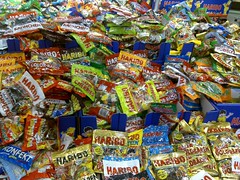I’ve been on a “simplicity” kick lately. In last month’s post I mentioned a discussion course called “Voluntary Simplicity” that I’ve been participating in. As someone who works in the field, I have been especially interested in the articles from our course readings that touch on marketing.
A History Lesson on Consumption
One of the course readings featured an excerpt from “The Gospel of Consumption” written by Jeffrey Kaplan. Kaplan begins with a little history lesson. He mentions that in 1919, horse drawn carriages were the common form of transportation and electricity was a luxury that only the wealthy could afford. Yet just 10 years later, cars dominated the streets, electric lights, refrigerators, radios, toasters and other household gadgets were commonplace. Clearly we were becoming a society of true consumers.
Despite this growth in consumer buying, Industrialists were worried that the manufacturing efficiencies gained by the burgeoning Industrial Revolution would quickly outpace consumer demand and that consumers would not change their penny-pinching ways. In short, we were able to make stuff way faster than people wanted to buy it.
Kaplan then goes on to describe an article that Charles Kettering, director of research at General Motors, wrote in 1929 called “Keep the Consumer Dissatisfied.” This article was not proposing that companies manufacture low quality goods. Rather, he was suggesting a shift: that our nation’s industries move from that of “fulfilling basic human needs to creating new ones.”
A Turning Point
It was then in the late 1920s, according to Kaplan, that business and political players began to recognize the power of advertising and promotion. That consumers could be convinced no matter how much they had, it would never be enough. Members of President Herbert Hoover’s Commission on Recent Economic Changes were enthusiastic about this discovery and stated in their report: “Economically we have a boundless field before us, that there are new wants which will make way endlessly for newer wants, as fast as they are satisfied.”
The birth of marketing as we know it today! Fast forward to the present day and we are faced with the consequences of our headlong rush to consumption. Today we are barraged by hundreds of advertising messages reaching us in media forms that were not even imagined in the 1920s. We are 7 billion and growing, living on a planet with dwindling resources, stressed eco-systems, a damaged environment and an island of plastic floating in our seas. We have, in short, made a mess of our planet in our quest to have more and more.
Those early Industrialists and politicians who once worried about supply outpacing demand certainly could not have imagined this scenario! Clearly the pendulum has swung in the other direction in terms of our consumption. Where is the balance?
Patagonia’s Buy Less Campaign
So after getting this little lesson in history, I found it especially refreshing when I came across a post about an advertising campaign asking consumers to “buy less.” That’s right. Patagonia is on a kick to counter our ever-increasing rates of consumption.
This is a retailer with a brand based on providing high quality clothing (albeit at a higher price) and known for its longer-term thinking. Through its marketing, Patagonia is encouraging its customers to buy less and buy only what they need and when they’re done with it, reuse or recycle it.
Patagonia has partnered with eBay so consumers can resell their used Patagonia clothing through the Common Threads initiative. Patagonia customers can also resell their used Patagonia clothing on the company website.
Patagonia could actually end up with more customers as a result of this campaign!
What a concept! Imagine if every company approached their business with this mindset versus the short-term capitalistic one we so often encounter today.
I envision a consumer utopia that would include high quality, super-efficient products, built to last and perform. You’d only need to buy one refrigerator, knowing it was made well and would last as long as your home was standing. Imagine if our computers, printers, cell phones, etc. lasted forever and upgrades for technology improvements could be plug-and-play. And then when you were done with your gadgets you could easily resell or recycle them. Imagine how much less stuff there would be to dispose of!
Capitalism for the Long Term
Okay, so I’m not an economist and realize this is taking a somewhat anti-capitalistic view of the world. But I prefer calling it capitalism with a longer term view.
I can hear what the economists of the world would say: We can’t have a vibrant growing economy if people didn’t keep buying stuff, if cell phones or computers weren’t obsolete in a year, if you only bought exactly what you needed and no more.
I disagree.
Clearly advertising and marketing can have an influence on consumption and the planet for good and for bad. The question is: which way is your company going to go?
Additional Reading:
The Guardian, Interview with Tensie Whelan: ‘We meet resistance every step of the way’
Curbing Consumption by Creating New Relationships with our Stuff
WorldWatch Institute Europe, Transforming Cultures
The Sustainable Business Blog, Advertising in itself is not evil: it is just communication
The Forbes CSR Blog, American Ingenuity





